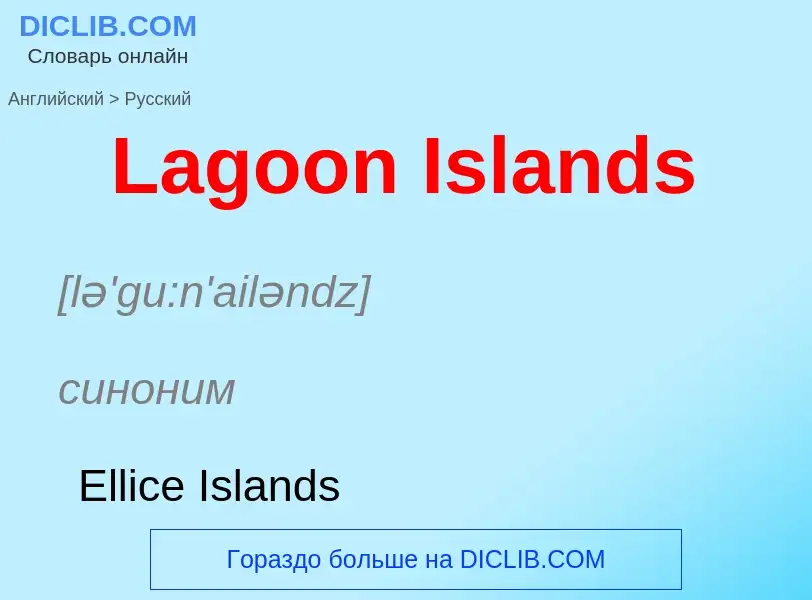Translation and analysis of words by ChatGPT artificial intelligence
On this page you can get a detailed analysis of a word or phrase, produced by the best artificial intelligence technology to date:
- how the word is used
- frequency of use
- it is used more often in oral or written speech
- word translation options
- usage examples (several phrases with translation)
- etymology
Lagoon Islands - translation to English
[lə'gu:n'ailəndz]
синоним
['elis'ailəndz]
география
острова Эллис
[tu:'vɑ:lu]
существительное
география
о-ва Тувалу
Тувалу (государство)
Definition
Wikipedia
Tuvalu ( (listen) too-VAH-loo or TOO-və-loo; formerly known as the Ellice Islands) is an island country and microstate in the Polynesian subregion of Oceania in the Pacific Ocean. Its islands are situated about midway between Hawaii and Australia. They lie east-northeast of the Santa Cruz Islands (which belong to the Solomon Islands), northeast of Vanuatu, southeast of Nauru, south of Kiribati, west of Tokelau, northwest of Samoa and Wallis and Futuna, and north of Fiji. Tuvalu is composed of three reef islands and six atolls. They are spread out between the latitude of 5° and 10° south and between the longitude of 176° and 180°. They lie west of the International Date Line. Tuvalu has a population of 11,204 (2021 world bank). The total land area of the islands of Tuvalu is 26 square kilometres (10 sq mi).
The first inhabitants of Tuvalu were Polynesians, according to well-established theories regarding a migration of Polynesians into the Pacific that began about three thousand years ago. Long before European contact with the Pacific islands, Polynesians frequently voyaged by canoe between the islands. Polynesian navigation skills enabled them to make elaborately planned journeys in either double-hulled sailing canoes or outrigger canoes. Scholars believe that the Polynesians spread out from Samoa and Tonga into the Tuvaluan atolls, which then served as a stepping stone for further migration into the Polynesian outliers in Melanesia and Micronesia.
In 1568, Spanish navigator Álvaro de Mendaña became the first European to sail through the archipelago, sighting the island of Nui during an expedition he was making in search of Terra Australis. The island of Funafuti was named Ellice's Island in 1819. Later, the whole group was named Ellice Islands by English hydrographer Alexander George Findlay. In the late 19th century, Great Britain claimed control over the Ellice Islands, designating them as within their sphere of influence. Between 9 and 16 October 1892, Captain Gibson of HMS Curacoa declared each of the Ellice Islands to be a British protectorate. Britain assigned a resident commissioner to administer the Ellice Islands as part of the British Western Pacific Territories (BWPT). From 1916 to 1975, they were managed as part of the Gilbert and Ellice Islands colony.
A referendum was held in 1974 to determine whether the Gilbert Islands and Ellice Islands should each have their own administration. As a result of the referendum, the Gilbert and Ellice Islands colony legally ceased to exist on 1 October 1975, and on 1 January 1976, the old administration was officially separated, and two separate British colonies, Kiribati and Tuvalu, were formed. On 1 October 1978, Tuvalu became fully independent as a sovereign state within the Commonwealth, and is a Constitutional Monarchy with King Charles III as King of Tuvalu. On 5 September 2000, Tuvalu became the 189th member of the United Nations.
The islands do not have a significant amount of soil, so rely heavily on imports and fishing for food. Licensing fishing permits to international companies, grants and aid projects, and remittances to their families from Tuvaluan seafarers who work on cargo ships are important parts of the economy. Because it is a small, low-lying island nation, the country is extremely vulnerable to sea level rise due to climate change. It is active in international climate negotiations as part of the Alliance of Small Island States.

![Taiwan President [[Tsai Ing-wen]] visits Governor-General of Tuvalu [[Iakoba Italeli]] in November 2017 Taiwan President [[Tsai Ing-wen]] visits Governor-General of Tuvalu [[Iakoba Italeli]] in November 2017](https://commons.wikimedia.org/wiki/Special:FilePath/11.01 總統會晤吐瓦魯總督 (38093830851).jpg?width=200)
![Stamps of the Gilbert and Ellice Islands with portraits of King [[George VI]] and Queen [[Elizabeth II]] Stamps of the Gilbert and Ellice Islands with portraits of King [[George VI]] and Queen [[Elizabeth II]]](https://commons.wikimedia.org/wiki/Special:FilePath/1939 & 1956 stamps of the Gilbert and Ellice Islands.jpg?width=200)

![A Tuvaluan dancer at Auckland's [[Pasifika Festival]] A Tuvaluan dancer at Auckland's [[Pasifika Festival]]](https://commons.wikimedia.org/wiki/Special:FilePath/Dancer, Tuvalu stage, 2011 Pasifika festival.jpg?width=200)
, Congregational Christian Church of Tuvalu.jpg?width=200)

![Woman on Funafuti (1900)<br />photography by [[Harry Clifford Fassett]] Woman on Funafuti (1900)<br />photography by [[Harry Clifford Fassett]]](https://commons.wikimedia.org/wiki/Special:FilePath/H-C-Fassett-Ellice-Is-1900.jpg?width=200)

![[[National Bank of Tuvalu]] [[National Bank of Tuvalu]]](https://commons.wikimedia.org/wiki/Special:FilePath/National Bank of Tuvalu.jpg?width=200)
![A man from the [[Nukufetau]] atoll, drawn by [[Alfred Thomas Agate]] in 1841 A man from the [[Nukufetau]] atoll, drawn by [[Alfred Thomas Agate]] in 1841](https://commons.wikimedia.org/wiki/Special:FilePath/Nukufetauman1831.jpg?width=200)

.png?width=200)


![[[Tuvalu Meteorological Service]], [[Fongafale]], Funafuti atoll [[Tuvalu Meteorological Service]], [[Fongafale]], Funafuti atoll](https://commons.wikimedia.org/wiki/Special:FilePath/Tuvalu Meteorology Service.jpg?width=200)

![[[Tuvalu national football team]] (2011) [[Tuvalu national football team]] (2011)](https://commons.wikimedia.org/wiki/Special:FilePath/Tuvalu national football team (team picture, 2011).jpg?width=200)


